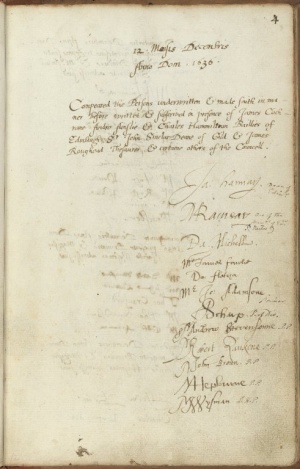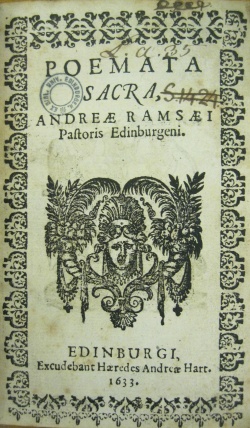Difference between revisions of "Andrew Ramsay (1574–1659)"
| Line 21: | Line 21: | ||
== Archives at Edinburgh University == | == Archives at Edinburgh University == | ||
| − | *Signature, 12 December 1636, [[Admissions Register, Edinburgh University Library]] (Da.2.1) | + | *Signature, 12 December 1636, [[Admissions Register, Edinburgh University Library]] (EUA IN1/ADS/LIB/3/Da.2.1) |
== Sources == | == Sources == | ||
Latest revision as of 12:53, 24 March 2015

Andrew Ramsay (1574–1659) was Edinburgh University’s first Professor of Divinity and first Rector.
Beginnings
Born in Fettercairn, Aberdeenshire, Ramsay was educated at Marischal College, Aberdeen. After graduating MA, he studied theology in France and taught at the University of Saumur. By 1606, he had returned to Scotland and was appointed Minister of Arbuthnott in the presbytery of Fordoun. Ramsay supported James VI and I’s religious policy, voting for the establishment of episcopacy in Scotland at the General Assembly of the Church of Scotland in 1610. As a reward, he was appointed Minister of Greyfriars, Edinburgh, in 1613. Despite his Royalist stance, Ramsay signed a 'protestation for the liberties of the Kirk’ of 1617, directed against James's measures to override the authority of the General Assembly. He regained the King’s favour by withdrawing his protest following a personal audience. His continued enjoyment of royal favour may have led to his appointment as Edinburgh University’s first Professor of Divinity in 1620.
Professor of Divinity and Rector
Hitherto, Robert Rollock (1555-1599) and Henry Charteris (c1565–1628) had combined the roles of Principal and ‘Professor of Theology’. In 1620, however, the Town Council of Edinburgh appointed a layman Patrick Sands (c1567-1635) to the Principalship, leading to the permanent separation of the two roles and the creation of a new Chair of Divinity. The establishment of the new Professorship was a small but significant step towards the creation of a Faculty of Divinity, and thus towards the expansion of the 'Tounis College' into a modern-day university. Ramsay resigned the chair in March 1626, citing the difficulties of combining the post with the Ministry of Greyfriars. He nonetheless continued to teach until 1627 when Henry Charteris returned in his place. Ramsay also held the title of Rector of the University, but appears to have regarded it as essentially symbolical. On his resignation, he acknowledged that the Rectorship had been ‘but an empty title’. He was succeeded by Sir Alexander Morison, Lord Prestongrange, who appears to have regarded the post in a similar light.
Later Years and Second Rectorship

Ramsay became Subdean of the Chapel Royal in 1629. In the 1630s he openly courted William Laud, Archbishop of Canterbury, but was frustrated in his hopes of achieving a bishopric. By 1637, he had adopted a nonconformist stance. He preached against the adoption of the new liturgy and canons, and urged his congregation to sign the National Covenant in 1638. He further expressed his support for the Covenant in A Warning to Come out of Babylon (1638). By 1640, when he served as Moderator of the General Assembly, he had fully adopted a Presbyterian position.
In 1646 Ramsay was reappointed Rector of Edinburgh University following the death of Alexander Henderson (c1583–1646). The role was by now was more firmly defined. While the Principal was responsible for the discipline, religious and moral control, and administration of the College, the Rector was ‘the eye of the Council of the Town’. He functioned as a supervisor or inspector on the Council’s behalf, but also as the spokesman for the College when making overtures to the Council. In this capacity, Ramsay, represented Edinburgh at a conference of Scotland’s four universities which sought to draw up a national curriculum for the teaching of philosophy. In 1648, Ramsay was deposed as Minister of Greyfriars by the General Assembly for refusing to denounce the military alliance (or ‘Engagement’) between a faction of the Scottish Covenanters and King Charles I. He was equally forced to stand down as Rector. Although the Synod of Lothian voted to reinstate him in 1655, Ramsay took no further role in church or university affairs. On his death in 1659, he left money to fund four divinity bursaries at the University.
Ramsay the Poet
Ramsay was highly regarded as a neo-Latin poet who wrote in the style of Ovid. In particular, his Poemata sacra, published in Edinburgh to coincide with the coronation of Charles I in 1633, were highly praised by the leading Scottish neo-Latinist Arthur Johnston. Johnston reprinted them in Delitiae poetarum Scotorum (Amsterdam, 1637), a highly successful anthology which gained an international reputation for the Scottish neo-Latin school.
Archives at Edinburgh University
- Signature, 12 December 1636, Admissions Register, Edinburgh University Library (EUA IN1/ADS/LIB/3/Da.2.1)
Sources
- Thomas Craufurd, History of the University of Edinburgh, from 1580 to 1646: To Which is Prefixed the Charter Granted to the College by James VI of Scotland, in 1582 (Edinburgh: Printed by A. Neill & Co., 1808)
- Sir Alexander Grant, The Story of the University of Edinburgh during its First Three Hundred Years, 2 vols (London: Longmans, Green, and Co., 1884)
- Vaughan T. Wells, 'Ramsay, Andrew (1574-1659)', Oxford Dictionary of National Biography (Oxford: Oxford University Press, 2004) [[[1], accessed 26 May 2014]